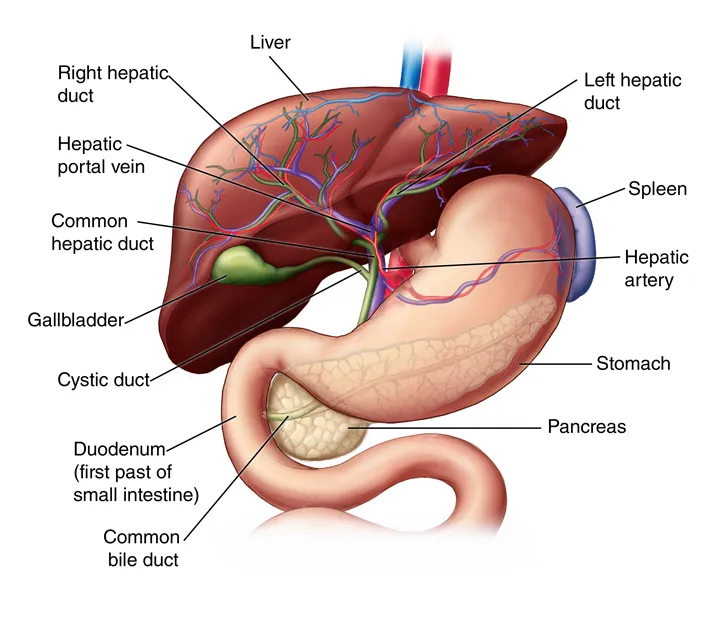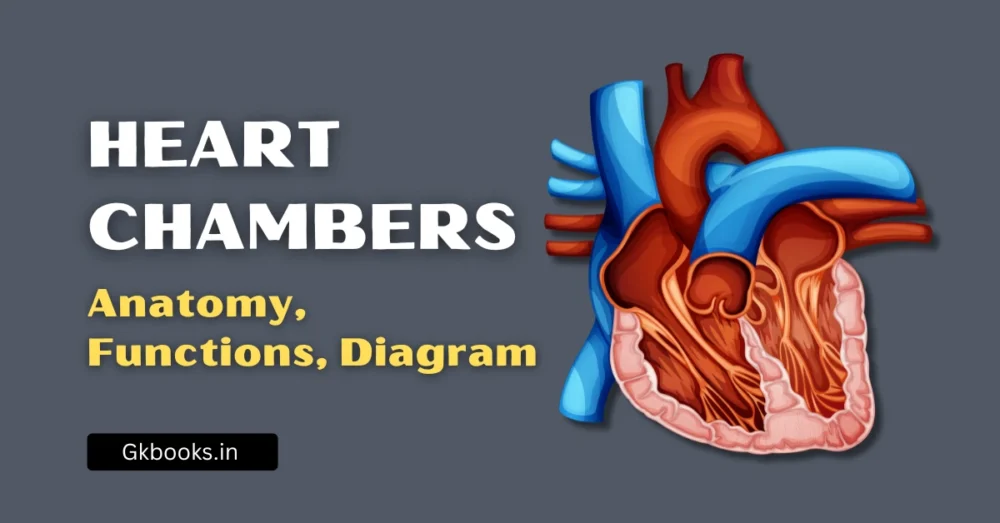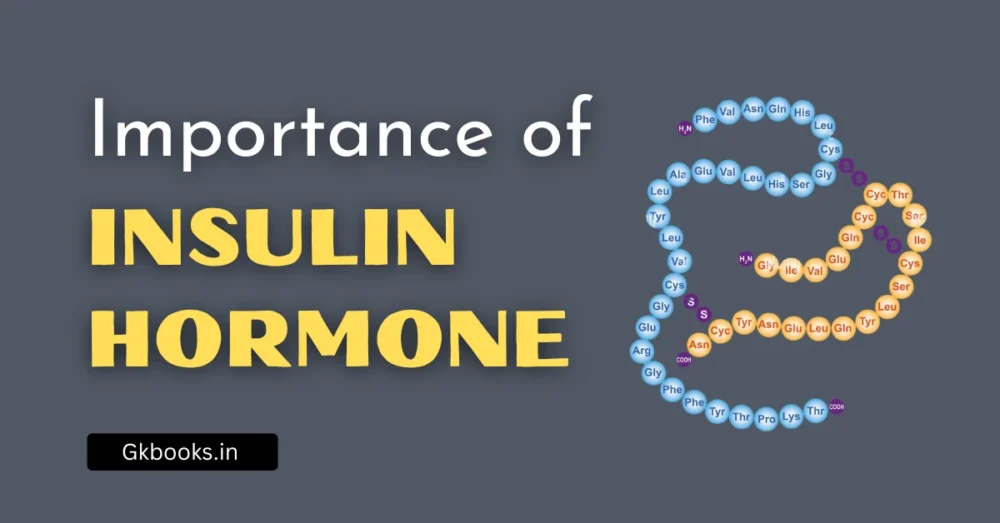The liver is one of the most important organs in our body. It is big, reddish-brown, and sits on the right side of our belly. The liver helps clean our blood, store energy, and digest food. In this blog, we will learn about the liver’s parts (anatomy), how it works (functions), and common liver diseases.
This topic is very important for exams like SSC, Banking, RRB NTPC, UPSC, and other state-level exams under General Science. Understanding the liver will help you answer many biology questions easily. We have explained everything in simple words to make your study quick and smart. Let’s dive into the world of the liver and boost your exam preparation!
📙Explore the Complete Biology Guide for Competitive Exams – Topics, Tips & Must-Know Facts!
Introduction to the Liver
- The liver is the largest internal organ and also the largest gland in the human body.
- It weighs about 1.2 to 1.5 kilograms in an average adult.
- The liver is located on the right side of the abdominal cavity, just below the diaphragm and above the stomach.
- Situated above the stomach, right kidney, and intestines.
- The only organ in the body with this remarkable regenerative capacity.
📝 Key Point:
👉 Largest gland = Liver
👉 Largest external organ = Skin

✅ Read Also: 6 Facts Everyone Should Know About The Liver
Anatomy of the liver
Appearance
- Shaped like a Triangle.
- Dark reddish-brown organ.
- Weighs approximately 3 pounds (1.36 KG).
- Protected by the rib cage.
Blood Supply
The liver gets blood from two sources:
- Hepatic artery – carries oxygen-rich blood.
- Hepatic portal vein – brings nutrient-rich blood from the intestines.
Blood Volume
- The liver holds about one pint (13%) of the body’s blood supply.
Internal Structure
- Consists of two main lobes.
- Each lobe has eight segments, composed of 1,000 lobules.
- Lobules are connected to small ducts that join larger ducts, forming the common hepatic duct.
- The common hepatic duct transports bile to the gallbladder and duodenum through the common bile duct.
Structural Details
- Triangular and bilobed structure.
- The falciform ligament separates the larger right lobe and the smaller left lobe.
- Covered by Glisson’s capsule, a layer of fibrous tissue, which is protected by the peritoneum.
Lobes of the Liver
The liver is divided into two main parts:
- Right lobe – larger part
- Left lobe – smaller part
| Part | Description |
|---|---|
| Right Lobe | Bigger, located on the right side |
| Left Lobe | Smaller, located on the left side |
Blood Sources
- The Hepatic Portal Vein carries nutrient-rich blood from the digestive system.
- The Hepatic Artery carries oxygenated blood from the heart.
Functions of the Liver
The liver is like a super factory in our body. It works 24/7, doing many important jobs. Here are the major functions:
1. Helps in Digestion
- Produces a juice called bile.
- Bile helps in breaking down fats into smaller parts so they can be easily digested.
🌟 Remember:
Bile = Fat Cutter
2. Stores Energy
- When we eat, extra glucose (sugar) is stored in the liver as glycogen.
- When needed, the liver converts glycogen back into glucose to provide energy.
3. Cleans the Blood
- Removes harmful substances like toxins, alcohol, and drugs from the blood.
- Acts like a filter.
🌟 Easy Tip:
Liver = Body’s Washing Machine
4. Makes Proteins
- Produces important proteins like:
- Albumin (helps maintain blood pressure)
- Clotting factors (help the blood to clot when we get a cut)
5. Stores Vitamins and Minerals
- Stores Vitamins A, D, E, K, and B12.
- Also stores iron and copper.
6. Helps Fight Infections
- Works as part of the immune system.
- Traps and removes germs and bacteria from the blood.
Liver Diseases
Understanding common liver diseases is important for both exams and general awareness. Below is a simplified and professional explanation of key liver diseases:
Fascioliasis
- Caused by a parasite known as the liver fluke.
- Parasites can remain inactive within the liver for extended periods, ranging from months to years.
Cirrhosis
- Caused by factors such as alcohol consumption, toxin exposure, and hepatitis infections.
- Scar tissue replaces healthy liver cells—a process known as fibrosis—leading to loss of liver function.
- May ultimately result in liver failure.
Hepatitis
- Inflammation of the liver caused by viruses such as Hepatitis A, B, and C.
- Can progress to severe complications, including liver failure if untreated.
Alcoholic Liver Disease
- Caused by excessive alcohol consumption over time.
- A major contributing factor to the development of cirrhosis.
Fatty Liver Disease
- Results from alcohol abuse or obesity.
- Characterized by the accumulation of fat in liver cells, forming vacuoles.
- Can lead to liver inflammation and, eventually, liver damage if not managed.
Liver Cancer
- Primarily caused by chronic alcohol consumption and long-term hepatitis infection.
- Two main types:
- Hepatocellular carcinoma – the most common form, arising from liver cells.
- Cholangiocarcinoma – cancer originating from the bile ducts.
🌟 Exam Tip:
Remember that cirrhosis often leads to liver failure, and hepatitis viruses are a major risk factor for both liver cancer and cirrhosis.
Important Terms Related to the Liver
| Term | Meaning |
|---|---|
| Bile | Greenish fluid that helps in fat digestion |
| Glycogen | Stored form of glucose (sugar) |
| Detoxification | Removing harmful substances from the blood |
| Hepatic | Anything related to the liver |
Regeneration of the Liver
The liver has a remarkable ability to regenerate after injury or partial removal. This capacity is present in all vertebrates.
- During the regeneration process, the liver continues to perform its essential functions, ensuring that the body’s needs are met without interruption.
Regeneration Duration
| Species | Approximate Regeneration Time |
|---|---|
| Humans | 8 to 15 days |
| Mice | 5 to 7 days |
- In humans, liver regeneration typically takes about 8 to 15 days.
- In mice, the process occurs more quickly, within approximately 5 to 7 days.
🌟 Key Insight:
The liver is the only internal organ capable of natural regeneration to such an extent, making it unique among human body organs.
Easy Mnemonic to Remember Liver Functions
“DIGS”
- D – Digestion (bile production)
- I – Immunity (fighting infections)
- G – Glucose storage (as glycogen)
- S – Synthesis (making proteins)






